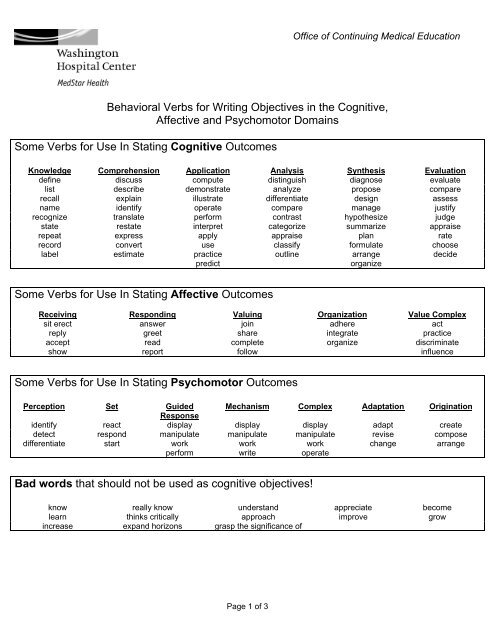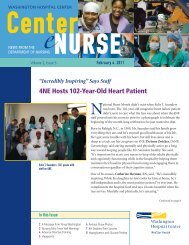Behavioral Verbs for Writing Objectives in the Cognitive, Affective ...
Behavioral Verbs for Writing Objectives in the Cognitive, Affective ...
Behavioral Verbs for Writing Objectives in the Cognitive, Affective ...
You also want an ePaper? Increase the reach of your titles
YUMPU automatically turns print PDFs into web optimized ePapers that Google loves.
Page 1 of 3<br />
Office of Cont<strong>in</strong>u<strong>in</strong>g Medical Education<br />
<strong>Behavioral</strong> <strong>Verbs</strong> <strong>for</strong> <strong>Writ<strong>in</strong>g</strong> <strong>Objectives</strong> <strong>in</strong> <strong>the</strong> <strong>Cognitive</strong>,<br />
<strong>Affective</strong> and Psychomotor Doma<strong>in</strong>s<br />
Some <strong>Verbs</strong> <strong>for</strong> Use In Stat<strong>in</strong>g <strong>Cognitive</strong> Outcomes<br />
Knowledge Comprehension Application Analysis Syn<strong>the</strong>sis Evaluation<br />
def<strong>in</strong>e discuss compute dist<strong>in</strong>guish diagnose evaluate<br />
list describe demonstrate analyze propose compare<br />
recall expla<strong>in</strong> illustrate differentiate design assess<br />
name identify operate compare manage justify<br />
recognize translate per<strong>for</strong>m contrast hypo<strong>the</strong>size judge<br />
state restate <strong>in</strong>terpret categorize summarize appraise<br />
repeat express apply appraise plan rate<br />
record convert use classify <strong>for</strong>mulate choose<br />
label estimate practice outl<strong>in</strong>e arrange decide<br />
predict organize<br />
Some <strong>Verbs</strong> <strong>for</strong> Use In Stat<strong>in</strong>g <strong>Affective</strong> Outcomes<br />
Receiv<strong>in</strong>g Respond<strong>in</strong>g Valu<strong>in</strong>g Organization Value Complex<br />
sit erect answer jo<strong>in</strong> adhere act<br />
reply greet share <strong>in</strong>tegrate practice<br />
accept read complete organize discrim<strong>in</strong>ate<br />
show report follow <strong>in</strong>fluence<br />
Some <strong>Verbs</strong> <strong>for</strong> Use In Stat<strong>in</strong>g Psychomotor Outcomes<br />
Perception Set Guided<br />
Response<br />
Mechanism Complex Adaptation Orig<strong>in</strong>ation<br />
identify react display display display adapt create<br />
detect respond manipulate manipulate manipulate revise compose<br />
differentiate start work work work change arrange<br />
per<strong>for</strong>m write operate<br />
Bad words that should not be used as cognitive objectives!<br />
know really know understand appreciate become<br />
learn th<strong>in</strong>ks critically approach improve grow<br />
<strong>in</strong>crease expand horizons grasp <strong>the</strong> significance of
1.<br />
2.<br />
3.<br />
4.<br />
5.<br />
6.<br />
Page 2 of 3<br />
Office of Cont<strong>in</strong>u<strong>in</strong>g Medical Education<br />
Table 1 a. Major Categories <strong>in</strong> <strong>the</strong> <strong>Cognitive</strong> Doma<strong>in</strong> of <strong>the</strong> Taxonomy of<br />
Educational <strong>Objectives</strong> (Bloom, 1956; from Gronlund)<br />
Descriptions of <strong>the</strong> Major Categories <strong>in</strong> <strong>the</strong> <strong>Cognitive</strong> Doma<strong>in</strong><br />
Knowledge. Knowledge is def<strong>in</strong>ed as <strong>the</strong> remember<strong>in</strong>g of previously learned material. This may<br />
<strong>in</strong>volve <strong>the</strong> recall of a wide range of material, from specific facts to complete <strong>the</strong>ories, but all that<br />
is required is <strong>the</strong> br<strong>in</strong>g<strong>in</strong>g to m<strong>in</strong>d of <strong>the</strong> appropriate <strong>in</strong><strong>for</strong>mation. Knowledge represents <strong>the</strong><br />
lowest level of learn<strong>in</strong>g outcomes <strong>in</strong> <strong>the</strong> cognitive doma<strong>in</strong>.<br />
Comprehension. Comprehension is def<strong>in</strong>ed as <strong>the</strong> ability to grasp <strong>the</strong> mean<strong>in</strong>g of material. This<br />
may be shown by translat<strong>in</strong>g material from one fom1 to ano<strong>the</strong>r (words, to numbers), by<br />
<strong>in</strong>terpret<strong>in</strong>g material (expla<strong>in</strong><strong>in</strong>g or summariz<strong>in</strong>g), and by estimat<strong>in</strong>g future trends (predict<strong>in</strong>g<br />
consequences or effects). These learn<strong>in</strong>g outcomes go one step beyond <strong>the</strong> simple remember<strong>in</strong>g<br />
of material, and represent <strong>the</strong> lowest level of understand<strong>in</strong>g.<br />
Application. Application refers to <strong>the</strong> ability to use learned material <strong>in</strong> new and concrete<br />
situations. This may <strong>in</strong>clude <strong>the</strong> application of such th<strong>in</strong>gs as rules, methods, concepts,<br />
pr<strong>in</strong>ciples, laws, and <strong>the</strong>ories. Learn<strong>in</strong>g outcomes <strong>in</strong> this area require a higher level of<br />
understand<strong>in</strong>g than those under comprehension.<br />
Analysis. Analysis refers to <strong>the</strong> ability to break down material <strong>in</strong>to its component parts so that its<br />
organizational structure may be understood. This may <strong>in</strong>clude <strong>the</strong> identification of <strong>the</strong> parts,<br />
analysis of <strong>the</strong> relationships between parts, and recognition of <strong>the</strong> organizational pr<strong>in</strong>ciples<br />
<strong>in</strong>volved. Learn<strong>in</strong>g outcomes here represent a higher <strong>in</strong>tellectual level than comprehension and<br />
application because <strong>the</strong>y require an understand<strong>in</strong>g of both <strong>the</strong> content and <strong>the</strong> structural fom1 of<br />
<strong>the</strong> material.<br />
Syn<strong>the</strong>sis. Syn<strong>the</strong>sis refers to <strong>the</strong> ability to put parts toge<strong>the</strong>r to <strong>for</strong>m a new whole. This may<br />
<strong>in</strong>volve <strong>the</strong> production of a unique communication (report or speech), a plan of operations<br />
(research proposal), or a set of abstract relations (scheme <strong>for</strong> classify<strong>in</strong>g <strong>in</strong>fom1ation). Learn<strong>in</strong>g<br />
outcomes <strong>in</strong> this area stress creative behaviors, with major emphasis on <strong>the</strong> <strong>for</strong>mulation of new<br />
patterns or structures.<br />
Evaluation. Evaluation is concerned with <strong>the</strong> ability to judge <strong>the</strong> value of material (statements,<br />
lab results, teach<strong>in</strong>g materials, journal articles) <strong>for</strong> a given purpose. The judgments are to be<br />
based on def<strong>in</strong>ite criteria. These may be <strong>in</strong>ternal criteria (organization) or external criteria<br />
(relevance to <strong>the</strong> purpose); <strong>the</strong> learner may ei<strong>the</strong>r determ<strong>in</strong>e <strong>the</strong> criteria or be given <strong>the</strong>m.<br />
Learn<strong>in</strong>g outcomes <strong>in</strong> this area are highest <strong>in</strong> <strong>the</strong> cognitive hierarchy because <strong>the</strong>y conta<strong>in</strong><br />
elements of all of <strong>the</strong> o<strong>the</strong>r categories, plus conscious judgments based on clearly def<strong>in</strong>ed<br />
criteria.
Page 3 of 3<br />
Office of Cont<strong>in</strong>u<strong>in</strong>g Medical Education<br />
TABLE 1 b. Examples of General Goals and <strong>Behavioral</strong> <strong>Verbs</strong><br />
<strong>for</strong> <strong>the</strong> <strong>Cognitive</strong> Doma<strong>in</strong> of <strong>the</strong> Taxonomy (Gronlund)<br />
Illustrative General Goals Illustrative <strong>Behavioral</strong> <strong>Verbs</strong><br />
Knowledge<br />
Knows common terms or specific facts<br />
Knows methods and procedures<br />
Knows basic concepts<br />
Knows pr<strong>in</strong>ciples<br />
Comprehension<br />
Understands facts and pr<strong>in</strong>ciples<br />
Interprets verbal material<br />
Interprets charts and graphs<br />
Translates verbal material to math <strong>for</strong>mulas<br />
Estimates future consequences implied <strong>in</strong> data<br />
Application<br />
Applies concepts and pr<strong>in</strong>ciples to new situations<br />
Applies laws and <strong>the</strong>ories to real situations<br />
Solves ma<strong>the</strong>matical problems<br />
Constructs charts and graphs<br />
Demonstrates use of a procedure<br />
Analysis<br />
Recognizes unstated assumptions<br />
Recognizes logical fallacies <strong>in</strong> reason<strong>in</strong>g<br />
Dist<strong>in</strong>guishes between facts and <strong>in</strong>ferences<br />
Evaluates <strong>the</strong> relevancy of data<br />
Analyzes <strong>the</strong> organizational structure of a work<br />
Syn<strong>the</strong>sis<br />
Writes a well-organized <strong>the</strong>me<br />
Gives a well-organized speech/presentation<br />
Proposes a plan <strong>for</strong> an experiment<br />
Integrates learn<strong>in</strong>g from different areas <strong>in</strong>to a plan <strong>for</strong> solv<strong>in</strong>g<br />
a problem<br />
Formulates a new scheme <strong>for</strong> classify<strong>in</strong>g facts<br />
Evaluation<br />
Judges <strong>the</strong> logical consistency of material<br />
Judges <strong>the</strong> adequacy with which conclusions are supported<br />
by data<br />
Judges <strong>the</strong> value of a work us<strong>in</strong>g <strong>in</strong>ternal criteria<br />
Judges <strong>the</strong> value of a work us<strong>in</strong>g external standards of<br />
excellence<br />
Def<strong>in</strong>es, describes, identifies, labels, lists,<br />
matches, names, outl<strong>in</strong>es, reproduces, selects,<br />
states<br />
Converts, defends, dist<strong>in</strong>guishes, estimates,<br />
expla<strong>in</strong>s, extends, generalizes, gives examples,<br />
<strong>in</strong>fers, paraphrases, predicts, rewrites,<br />
summarizes<br />
Changes, computes, demonstrates, discovers,<br />
manipulates, modifies, operates, predicts,<br />
prepares, produces, relates, shows, solves, uses<br />
Breaks down, diagrams, differentiates,<br />
discrim<strong>in</strong>ates, dist<strong>in</strong>guishes, identifies, illustrates,<br />
<strong>in</strong>fers, outl<strong>in</strong>es, po<strong>in</strong>ts out, relates, selects,<br />
separates, subdivides.<br />
Categorizes. comb<strong>in</strong>es, compiles, composes,<br />
creates, devises, designs, expla<strong>in</strong>s, generates,<br />
modifies, organizes, plans, rearranges,<br />
reconstructs, relates, reorganizes, revises,<br />
rewrites, summarizes, tells, writes<br />
Appraises, compares, concludes, contrasts,<br />
criticizes, describes, discrim<strong>in</strong>ates, expla<strong>in</strong>s,<br />
justifies, <strong>in</strong>terprets, relates, summarizes,<br />
supports
















